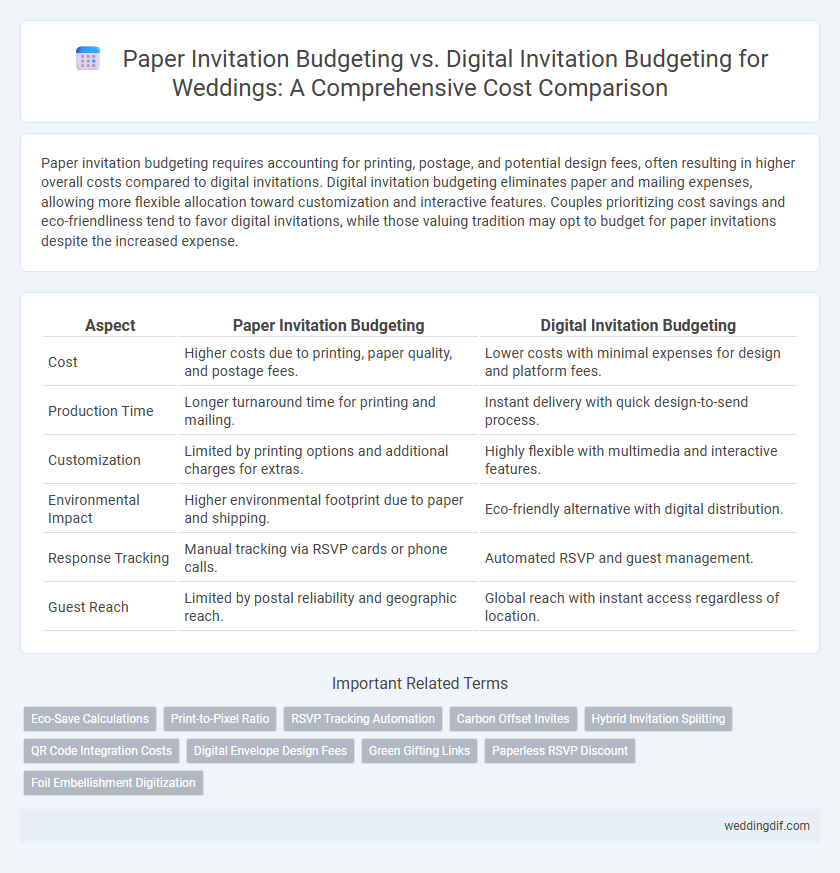Paper invitation budgeting requires accounting for printing, postage, and potential design fees, often resulting in higher overall costs compared to digital invitations. Digital invitation budgeting eliminates paper and mailing expenses, allowing more flexible allocation toward customization and interactive features. Couples prioritizing cost savings and eco-friendliness tend to favor digital invitations, while those valuing tradition may opt to budget for paper invitations despite the increased expense.
Table of Comparison
| Aspect | Paper Invitation Budgeting | Digital Invitation Budgeting |
|---|---|---|
| Cost | Higher costs due to printing, paper quality, and postage fees. | Lower costs with minimal expenses for design and platform fees. |
| Production Time | Longer turnaround time for printing and mailing. | Instant delivery with quick design-to-send process. |
| Customization | Limited by printing options and additional charges for extras. | Highly flexible with multimedia and interactive features. |
| Environmental Impact | Higher environmental footprint due to paper and shipping. | Eco-friendly alternative with digital distribution. |
| Response Tracking | Manual tracking via RSVP cards or phone calls. | Automated RSVP and guest management. |
| Guest Reach | Limited by postal reliability and geographic reach. | Global reach with instant access regardless of location. |
Introduction to Wedding Invitation Budgeting
Wedding invitation budgeting requires careful consideration of cost differences between paper and digital invitations, with paper options typically involving printing, design, and postage expenses averaging $1.50 to $3.00 per invite. Digital invitations reduce costs significantly by eliminating physical materials and mailing fees, often ranging from free to $1.00 per recipient for advanced platforms. Couples should evaluate guest count, aesthetic preferences, and overall wedding budget to optimize invitation spending effectively.
Overview: Paper vs Digital Wedding Invitations
Paper wedding invitation budgeting typically includes costs for printing, envelopes, postage, and possible hand assembly, often resulting in higher expenses due to material and labor. Digital invitation budgeting minimizes these costs by leveraging email or specialized platforms, drastically reducing expenses related to printing and mailing while offering features like RSVP tracking. Evaluating overall budgeting differences, couples should consider guest count, desired customization, and delivery timing to balance traditional appeal with cost efficiency.
Cost Breakdown: Printing and Mailing Paper Invitations
Paper invitation budgeting for weddings involves significant costs including printing, materials like high-quality cardstock, and mailing expenses such as postage and envelopes, often leading to higher overall expenses compared to digital invitations. Printing costs vary depending on design complexity, color quality, and quantity, while mailing expenses fluctuate based on weight, size, and destination, substantially increasing the budget. Digital invitations eliminate printing and postage charges, offering a cost-effective solution that reduces budget allocation for physical materials and delivery logistics.
Digital Invitations: Pricing and Popular Platforms
Digital wedding invitations offer cost-effective pricing with platforms like Paperless Post, Minted, and Evite providing customizable templates that reduce expenses on printing and postage. These services typically charge per guest or offer subscription models, making it easier to scale budgets based on attendee count. Popular platforms also include features for RSVP tracking, event reminders, and integration with wedding websites, enhancing convenience and overall value.
Hidden Fees and Unexpected Costs
Paper wedding invitations often incur hidden fees such as higher postage due to weight, additional costs for envelopes or liners, and expenses for printing errors or design adjustments. Digital invitations reduce unexpected costs by eliminating postage and physical materials, but may include fees for premium design templates or online platform subscriptions. Evaluating these hidden expenses is crucial for accurate budgeting when choosing between paper and digital wedding invitations.
Personalization and Design Expenses
Paper invitation budgeting for weddings typically includes higher costs for personalized printing techniques, embellishments, and unique materials that enhance tactile design appeal. Digital invitation budgeting reduces expenses by offering customizable templates and interactive design options without the need for physical production. Personalization in digital invites leverages dynamic content and multimedia features, enabling creative design flexibility within a lower budget compared to traditional paper invitations.
Tracking RSVPs: Manual vs Automated Solutions
Paper invitation budgeting often includes costs for printing, postage, and RSVP tracking via mail or phone, requiring manual entry and increased time for organizing responses. Digital invitation budgeting typically incorporates software fees or subscription costs, offering automated RSVP tracking that updates guest lists in real-time and reduces errors. Automated solutions streamline budget management by minimizing labor and providing clear insights into attendance, enhancing overall wedding planning efficiency.
Environmental Considerations and Budget Impact
Paper invitation budgeting for weddings involves higher costs due to printing, materials, and postage, which can significantly increase the overall budget. Digital invitation budgeting reduces expenses by eliminating printing and mailing fees, offering a more cost-effective solution. Environmentally, digital invitations minimize paper waste and carbon footprint, aligning with sustainable wedding planning practices.
Time and Convenience: Efficiency in Budgeting
Digital invitation budgeting significantly reduces time spent on design, printing, and distribution compared to paper invitations, streamlining the overall process. Automated RSVP tracking and instant updates minimize manual follow-ups, enhancing convenience and accuracy in budget management. Choosing digital methods often results in a more efficient allocation of resources and quicker adjustments to event planning expenses.
Final Considerations: Choosing the Right Invitation Method for Your Budget
Assessing paper invitation budgeting against digital invitation budgeting for weddings involves comparing printing, postage, and design costs with the low overhead of digital platforms and email services. Paper invitations often incur higher expenses due to materials and labor, while digital invitations offer cost savings and instant delivery, influencing the overall event budget allocation. Selecting the appropriate invitation method depends on balancing your wedding budget priorities, guest experience preferences, and the desired aesthetic impact.
Paper Invitation Budgeting vs Digital Invitation Budgeting for weddings. Infographic

 weddingdif.com
weddingdif.com